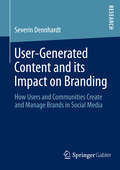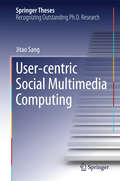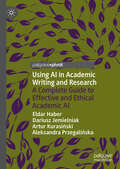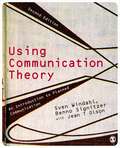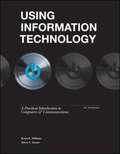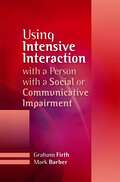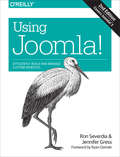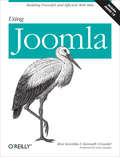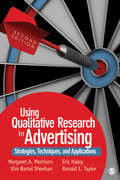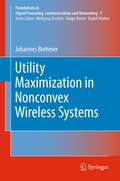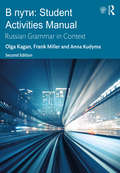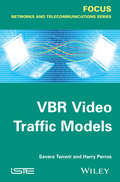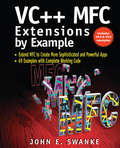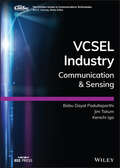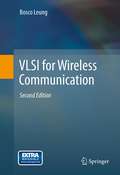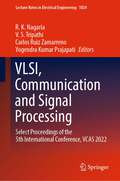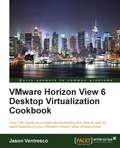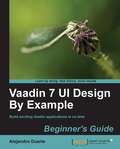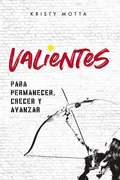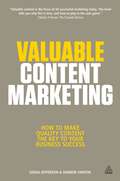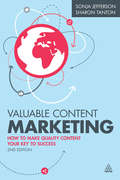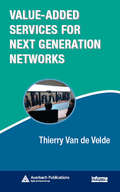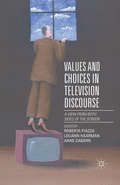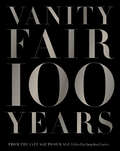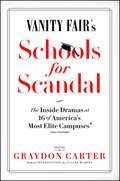- Table View
- List View
User-Generated Content and its Impact on Branding
by Severin DennhardtThe emergence of social media as one of the driving forces of consumers' online experiences today also challenges our current understanding on marketing and brand management. The effects of brands' social media involvement are to this day uncertain. Severin Dennhardt shows that social media and user-generated brands do have a strong influence on brands. Four independent studies demonstrate that first, successful brands can be created in virtual worlds, second, user-generated content drives the creation of unique brands, third social media strongly influences the social value perception of brands, and fourth, social media impacts consumers' purchase decision process.
User-centric Social Multimedia Computing
by Jitao SangThis book presents the first paradigm of social multimedia computing completely from the user perspective. Different from traditional multimedia and web multimedia computing which are content-centric, social multimedia computing rises under the participatory Web2. 0 and is essentially user-centric. The goal of this book is to emphasize the user factor in facilitating effective solutions towards both multimedia content analysis, user modeling and customized user services. Advanced topics like cross-network social multimedia computing are also introduced as extensions and potential directions along this research line.
Using AI in Academic Writing and Research: A Complete Guide to Effective and Ethical Academic AI
by Dariusz Jemielniak Eldar Haber Aleksandra Przegalińska Artur KurasińskiThis book comprehensively explores how AI tools can revolutionize academic writing, research, grant proposals, and educational practices. With a focus on practical applications, ethical considerations, and future trends, the book serves as an indispensable roadmap for academics, researchers, and educators eager to integrate AI into their work. Whether you're looking to enhance your research capabilities, craft compelling grant proposals, personalize learning experiences, or lead your institution into the future, this book provides the insights and tools necessary to navigate and shape the AI-enhanced landscape of academia. It demonstrates how to redefine scholarly work with cutting-edge AI innovations through real-life, practical examples, yet keeping the level of generalization high enough to keep it relevant for a few years. By balancing specific, actionable insights with broader perspectives, this book equips readers to not only adapt to but actively influence the evolving role of AI in higher education, research, and funding acquisition, ensuring its value as a resource both now and in the coming years.
Using Communication Theory: An Introduction to Planned Communication
by Sven Windahl Benno H. Signitzer Jean T. Olsen‘Using Communication Theory was a rarity in bridging the gap between ideas and practice. It was itself a model of good communication and in its second, revised edition, it is still a most reliable and accessible guide to the lessons that communication theory and research offer to practitioners, especially in planning for change' - Denis McQuail, Professor Emeritus, University of Amsterdam ‘Using Communication Theory has become a classic in the education of communication. It is the comprehensive and self-evident source for theories and models, forming the base for the study of professions requiring communication planning' - Larsåke Larsson, Örebro University What does theory have to do with the practice of communication? Communication planning is used daily by thousands of people: public relations practitioners, technical writers, information campaigners, advertising professionals, organization consultants, educators, health communicators and more. Without a solid understanding of communication theory, practitioners have difficulty getting their messages heard. The second edition of this best-selling textbook has been updated with the student firmly in mind. With new learning features that directly engage with the practical side of theory, students will: · Practice what they learn with activities and exercises · Apply their own experiences to theory through prompts to reflection · Consolidate their learning with highlighted definitions and lists of key terms · Take it further with boxed excerpts from classic texts Showing how theories relate directly to the planning and experience of effective communication, Using Communication Theory - 2nd Edition provides indispensable insights into the practical nature of communication theory. In today’s landscape of communication overload, this book remains an essential, authoritative guide for both students and practitioners. Sven Windahl is based at the Nordisk Kommunikation. Benno Signitzer is Professor of Communication Studies at the University of Salzburg. Jean T Olson works in the public sector.
Using Information Technology (Tenth Edition)
by Brian Williams Stacey SawyerUSING INFORMATION TECHNOLOGY; A Practical Introduction to Computers & Communications 10/e "If there is anything we have learned during 18 years of writing and revising this computer concepts book, it is this: Not only does the landscape of computer education change rapidly, but so do the students. . . . This edition, then, is written for the Always On generation, helping students use technology to enrich their personal lives. " -Brian K. Williams & Stacey C. Sawyer
Using Intensive Interaction with a Person with a Social or Communicative Impairment
by Mark Barber Graham FirthIntensive Interaction is a highly effective approach for communicating and developing social interaction and engagement with difficult-to-reach individuals. This easy-to-use guide steers readers through the practical application of the approach, showing how positive results can best be achieved. The authors explain clearly how to prepare for, carry out and reflect on the use of Intensive Interaction with a client or family member. A multitude of key questions are addressed, including finding the right setting, evaluating progress and disengaging effectively at the end of a session. In the final section they consider some of the wider implications of the approach, such as developing confidence as a practitioner and incorporating Intensive Interaction into long-term care or educational planning. This practical and accessible book is a useful resource for speech and language therapists, occupational therapists, special school or further education teachers, social care professionals and anyone else caring for or working with people with social or communicative impairments. It will also be useful to practitioners already using the approach.
Using Joomla!: Efficiently Build and Manage Custom Websites
by Ron Severdia Jennifer GressIf you’re new to content management systems—or even new to building websites—this practical guide will get you up and running in no time. You don’t have to know much code, if any, to get started.Need to build a website quickly? Have a client that requires a powerful website with lots of compelling features? Ideal for web designers and developers alike, this updated edition takes you step-by-step through site creation with Joomla, with plenty of hands-on exercises along the way.Build a sample site throughout the book to see how Joomla! worksPlan and structure your site’s categories, articles, menus, and modulesLearn the ins and outs of creating, organizing, and displaying contentAdd images, audio, and video—and create complete image galleriesBuild a blog, set up an events calendar, and create custom user formsSell merchandise by putting together your own online storeEngage visitors by creating user profiles and hangoutsSecure your site and keep it optimizedMigrate to Joomla! 3 and update your third-party extensions
Using Joomla: Building Powerful and Efficient Web Sites
by Ron Severdia Kenneth CrowderWhy use Joomla? Because with Joomla you don't need to have any technical expertise or web design experience to create effective websites and web apps. Whether you're creating your first website or building a multi-function site for a client, this book provides straightforward, hands-on instruction that makes it easy to learn this open source web content management system.Written by members of the Joomla Leadership Team, Using Joomla helps newcomers quickly learn the basics, while developers with Joomla experience will pick up best practices for building more sophisticated websites. You'll also find more than a dozen ways to extend the functionality of existing Joomla-built websites. Start building with Joomla in minutes!Get guidelines for planning, creating, and organizing your contentUnderstand how to create and use Joomla templates to build websites quicklyExplore how components, modules, and plug-ins can extend your site's functionalityIncrease your site ranking by using Joomla best practicesUse built-in components such as banners, news feeds, polls, search, and web linksSet up an online store, calendar, photo gallery, discussion forum, and moreLearn important security precautions to safeguard your site
Using Qualitative Research in Advertising: Strategies, Techniques, and Applications (2nd Edition)
by Kim B. Sheehan Dr Margaret A. Morrison Dr Eric E. Haley Dr Ronald E. TaylorThis Second Edition remains the only book to discuss both theory and application of qualitative research techniques to inspire great advertising and build strong brands. Using a step-by-step approach created for students considering advertising careers and for those currently working in the advertising industry, this book explains what qualitative research techniques are designed to do. The text describes how these techniques aid in uncovering insights useful for advertising strategy development, creative development, and post-campaign evaluation. Practical information and discussions on interviewing, projective techniques, focus groups, and online/social media applications positioned within a theoretical context illustrate the value of qualitative research in the real world.
Utility Maximization in Nonconvex Wireless Systems
by Johannes BrehmerThis monograph develops a framework for modeling and solving utility maximization problems in nonconvex wireless systems. The first part develops a model for utility optimization in wireless systems. The model is general enough to encompass a wide array of system configurations and performance objectives. Based on the general model, a set of methods for solving utility maximization problems is developed in the second part of the book. The development is based on a careful examination of the properties that are required for the application of each method. This part focuses on problems whose initial formulation does not allow for a solution by standard methods and discusses alternative approaches. The last part presents two case studies to demonstrate the application of the proposed framework. In both cases, utility maximization in multi-antenna broadcast channels is investigated.
V Puti: Russian Grammar in Context
by Frank Miller Olga Kagan Anna KudymaThis highly successful program assists in the development of all the language skills (listening, speaking, reading and writing) by presenting realistic settings, situations and contexts. It consists of 12 chapters and can be used in an intermediate or advanced Russian course. V Puti offers conversational exercises, various readings (biographies, poems, literature and historical texts) and grammatical explanations and practice. All of these components reinforce Russian culture and history which enable the students to understand the Russian language in context. V Puti: Student Activities Manual is an integral part of the V Puti course. The structure matches the main textbook and provides a wealth of exercises and activities, either for class-use or homework.
VBR Video Traffic Models (Focus Ser.)
by Harry G. Perros Savera TanwirThere has been a phenomenal growth in video applications over the past few years. An accurate traffic model of Variable Bit Rate (VBR) video is necessary for performance evaluation of a network design and for generating synthetic traffic that can be used for benchmarking a network. A large number of models for VBR video traffic have been proposed in the literature for different types of video in the past 20 years. Here, the authors have classified and surveyed these models and have also evaluated the models for H.264 AVC and MVC encoded video and discussed their findings.
VC++ MFC Extensions by Example
by John SwankeExtend and modify MFC code to meet your needs! Author John Swanke delivers studied examples to give you a jump-start on creating more sophisticated and powerful applications. Each example is fully annotated and ready to insert into the your application --
VCSEL Industry: Communication and Sensing (The ComSoc Guides to Communications Technologies)
by Kenichi Iga Babu Dayal Padullaparthi Jim TatumA hands-on reference to the technical, commercial, and industrial aspects of VCSEL technology In VCSEL Industry: Communication and Sensing, a team of distinguished researchers and manufacturing professionals deliver a thorough and practical reference guide to vertical-cavity surface-emitting lasers (VCSELs) for young entrepreneurs, investors, venture capitalists, and researchers. The authors offer comprehensive descriptions of the technology involved, as well as a robust exploration of the industry and commercial landscape in which VCSELs exist. In VCSEL Industry: Communication and Sensing, distinguished researchers and manufacturing professionals Dr. Padullaparthi Babu Dayal, Dr. Jim A Tatum and Prof. Kenichi Iga deliver a thorough and practical reference guide to vertical-cavity surface-emitting lasers (VCSELs) for young entrepreneurs, investors, venture capitalists, and researchers. The authors offer comprehensive descriptions of the technology involved, as well as a robust exploration of the industry and commercial landscape in which VCSELs exist. The book contains numerous illustrations and schematics of the anatomy of VCSEL product developments and an insightful discussion of the proliferation of VCSELs in photonics and optics. There is also a dedicated section on photoreceivers used for VCSEL-based data communications and sensing. VCSEL Industry: Communication and Sensing provides readers with an accessible, commercial perspective of an important technology while offering just enough technical detail to make sense of the subject. The book also includes: A thorough introduction to VCSELs, including discussions of semiconductor lasers, materials, wavelengths, and why VCSELs are attractive for photonics applications Comprehensive explorations of the VCSEL industry, including market demands, an industry landscape, descriptions of commercial products based on VCSELs, and business models Practical discussions of VCSELs for data communication, including high-speed VCSELs, gain and parasitic effects on bandwidth and speed, and form factors and standards In-depth examinations of VCSEL arrays for sensing, including high-power VCSELs in consumer electronics Perfect for early-career researchers, engineers, entrepreneurs, investors, and managers, VCSEL Industry: Communication and Sensing will also prove to be an invaluable addition to the libraries of executives from across the semiconductor industry.
VLSI for Wireless Communication
by Bosco LeungVLSI for Wireless Communication, Second Edition, an advanced level text book, takes a system approach starting with an overview of the most up to date wireless systems and the transceiver architecture available today. Wireless standards are first introduced (updated to include the most recent 3G/4G standards in the second edition), and translates from a wireless standard to the implementation of a transceiver. This system approach is particularly important as the level of integration in VLSI increases and coupling between system and component design becomes more intimate. VLSI for Wireless Communication, Second Edition, illustrates designs with full design examples. Each chapter includes at least one complete design example that helps explain the architecture/circuits presented in this text. This book has close to 10 homework problems at the end of each chapter. A complete solutions manual is available on-line. VLSI for Wireless Communication, Second Edition, is designed as a primary text book for upper-undergraduate level students and graduate level students concentrating on electrical engineering and computer science. Professional engineers and researchers working in wireless communications, circuit design and development will find this book valuable as well.
VLSI, Communication and Signal Processing: Select Proceedings of the 5th International Conference, VCAS 2022 (Lecture Notes in Electrical Engineering #1024)
by R. K. Nagaria V. S. Tripathi Carlos Ruiz Zamarreno Yogendra Kumar PrajapatiThis book covers a variety of topics in Electronics and Communication Engineering, especially in the area of microelectronics and VLSI design, communication systems and networks, and signal and image processing. The content is based on papers presented at the 5th International Conference on VLSI, Communication and Signal Processing (VCAS 2022). The book also discusses the emerging applications of novel tools and techniques in image, video, and multimedia signal processing. This book is useful to students, researchers, and professionals working in the electronics and communication domain.
VMware Horizon View 6 Desktop Virtualization Cookbook
by Jason VentrescoIf you want a more detailed explanation concerning the implementation of several different core features of VMware Horizon View, this is the book for you. Whether you are new to VMware Horizon View or an existing user, this book will provide you with the knowledge you need to successfully deploy several core features and get introduced to the latest features of version 6.0 as well.
Vaadin 7 UI Design By Example: Beginner’s Guide
by Alejandro DuarteThis book is a hands-on Beginner's Guide for developers who are new to Vaadin and/or Vaadin UI components. The book will teach readers through examples to use each of the exciting components to build and add various aspects of the user interface to their web apps.If you have experience with the Java language and want to create web applications that look good without having to deal with HTML, XML, and JavaScript, this book is for you. Basic Java programming skills are required, but no web development knowledge is needed at all.
Valientes: Para permanecer, crecer y avanzar
by Kristy MottaSé valiente para soltar lo que Dios te pide. Sé valiente para abrazar lo que Dios te da. Sé valiente para no juzgar a los demás. Sé valiente para vivir solo para obtener su aprobación. Los cambios son una variable constante en la vida; no son opcionales. Es cierto que, al enfrentar una tragedia, crisis o cambio sentirás miedo, querrás renunciar, te lamentarás, buscarás culpables, querrás huir y, cuando estés a punto de sentirte una cobarde, tu corazón creerá que ha sido diseñado para más. Entonces, estarás por experimentar la intervención divina y sobrenatural de Dios que activará a la mujer valiente que está dentro de ti, lista para permanecer, crecer y avanzar. Cada paso de valentía revelará tu estado actual y el carácter que Dios quiere forjar en ti para vivir una vida más enriquecida y mantenerte firme en el Dios que no cambia.
Valuable Content Marketing
by Sonja Jefferson Sharon TantonUnthink what you've learned about sales and marketing communication. If you want to engage potential customers and help your business stand out from the crowd, you need to start doing things differently. From websites to white papers, blogs to tweets, to newsletters and video, now more than ever content is king in the digital world. Get it right and you have a huge opportunity to connect with clients and customers in ways they appreciate and trust - they'll soon be knocking at your door wanting to do business with you. Valuable Content Marketing shows you how to create and share the type of information that clients, customers and search engines really want - on your website, using social media, and through traditional print methods. Whether you're starting a business or looking to grow, this book shows you how to get better results from your marketing efforts.
Valuable Content Marketing
by Sonja Jefferson Sharon TantonFrom websites, white papers and blogs to tweets, newsletters and video, content is king in the digital world, now more than ever. When businesses get it right and create the type of marketing people love they have a huge opportunity to connect with clients and customers in ways their customers appreciate, trust and want. Valuable Content Marketing shows how to create and share valuable content on websites and through social media and more traditional methods. This fully revised second edition of Valuable Content Marketing is a practical, focused guide to effective marketing. It includes new ideas and examples, step-by-step action lists, quick tips and goal-driven chapter summaries to make understanding the key concepts easier than ever. Perfect for sales, marketing and branding professionals as well as small business owners or practitioners in publicity or corporate communications, it provides inspiration from companies of all sizes that have got valuable content marketing right, from small companies like software development firm Desynit to household names like Accenture.
Value-Added Services for Next Generation Networks
by Thierry Van de VeldeIn the NGN world, no truer words are spoken than "the future is now." And the competition in the information networking arena will only intensify in the next 5-10 years. Choosing the correct NGN-VAS strategy now will set your company apart. Value Added Services for Next Generation Networks examines the quest for the real added value in modern commu
Values and Choices in Television Discourse: A View from Both Sides of the Screen
by Roberta Piazza Louann Haarman Anne CabornThe high-pressured, fast-paced environment of television production leaves little time for producers to reflect on how the potentialities of texts and images will be interpreted outside of the immediate broadcast imperatives. This volume brings together the producers and analysts of television in a formal and productive way.
Vanity Fair 100 Years: From the Jazz Age to Our Age
by Graydon Carter&“Page after page of stunningly rendered images. . . . go to the party that is Vanity Fair. This time, we&’re all invited.&” —The New York Times In words, photography, and illustrations, this book spans a century of personality and power, art and commerce, current events, crises, and culture both highbrow and low, as chronicled in the magazine Vanity Fair. From its inception in 1913, through the Jazz Age and the Depression, to its reincarnation in the boom-boom Reagan years, to the image-saturated Information Age, Vanity Fair has presented the modern era as it unfolded, using wit, imagination, peerless literary narrative, and bold, groundbreaking imagery from the greatest photographers, artists, and illustrators of the day. This sumptuous book takes a decade-by-decade look at the world as seen by the magazine, with stops to describe the incomparable editor Frank Crowninshield and the birth of the Jazz Age Vanity Fair, the magazine&’s controversial rebirth in 1983, and the history of the glamorous Vanity Fair Oscar Party.
Vanity Fair's Schools For Scandal: The Inside Dramas at 16 of America's Most Elite Campuses—Plus Oxford!
by Graydon CarterVanity Fair editor Graydon Carter shares a definitive, provocative collection of the magazine’s finest dispatches on the political, sexual, and administrative scandals that have swept our nation’s campuses.Vanity Fair’s Schools for Scandal, edited by Graydon Carter, with an introduction by Cullen Murphy, brings together the magazine’s finest reporting on the scandals that have swept our nation’s most elite campuses over the past twenty-five years—all in one definitive, provocative volume. The stories collected here speak to an American obsession with status and to the lengths we will go to achieve it, preserve it, or destroy it—from the enduring, shadowy influence of Yale’s secret societies to the infamous “senior salute” at St. Paul’s School; from the false accusations in the Duke lacrosse team’s infamous rape case to the (mis)reportage of a sexual assault at the University of Virginia; from a deadly extreme-sport episode at Oxford to the Keystone Kop theft of a college’s rare books to the allegations of fraud by the now-shuttered Trump University. Vanity Fair’s Schools for Scandal brings focus to the perils facing American education today and how the life of the mind, and the significance of the institutions meant to foster it, has been negatively impacted by the partisan politics of privatization, tensions over so-called political correctness, the fraught dynamic of the teacher-student relationship, and what happens when visions for a bold future collide with the desire to maintain hidebound (or venerable) traditions. With an array of Vanity Fair’s signature writers—including Buzz Bissinger, William D. Cohan, Sarah Ellison, Evgenia Peretz, Todd S. Purdum, and Sam Tanenhaus, among others—Vanity Fair’s Schools for Scandal presents a compelling if troubling account of the state of elite education today, and the evolving social, sexual, racial, and economic forces that have shaped it.
